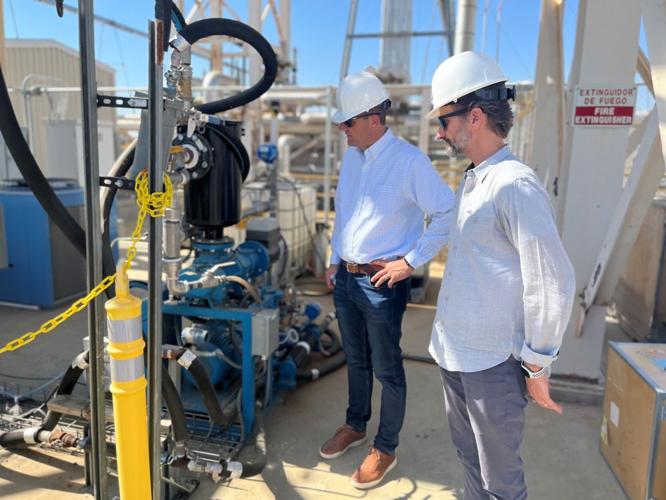Pilot Project Near Shafter Removes Carbon, Produces Water
Published by Todd Bush on August 12, 2024
A demonstration project near Shafter is testing technology for removing carbon dioxide directly from the atmosphere without the need for water — a big advantage in Kern, which has plenty of the resources required except that one.
Avnos Inc. calls this approach hybrid direct air capture (HDAC). This year, the Los Angeles-New Jersey startup raised $36 million on the promise that its patented approach can be scaled up around the world at a lower cost, with fewer barriers, and possibly more local buy-in than other technology on the market.

Rep. David Valadao tours a carbon removal pilot facility in the Bakersfield area. Though skeptics continue to object to such projects for safety and other reasons, the new industry of carbon management views Kern as ideal for its geology, infrastructure and industrial know-how.
>> In Other News: ArtIn Energy Secures Monumental $25.4 Billion Green Hydrogen Contract To Reduce 25.5 Million Tons in CO2 Emissions
Avnos, founded in May 2020, licenses out its technology instead of building its own large projects. As such, it is a partner in four direct air carbon removal projects — two proposed in Kern — that the U.S. Department of Energy has selected for multimillion-dollar grants for addressing climate change.
The company says it is also working with the U.S. Office of Naval Research at a scale 15 times larger than the facility north of Bakersfield.
Avnos' machine dehumidifies air before using chemicals to soak up CO2. Heat produced in the process is then redirected for use in releasing the gas and water.
The model being tested north of Bakersfield, called Project Alpine, collects but does not currently store CO2. With a capacity of 30 metric tons of CO2 per year, it produces five times that amount of distilled water, or about 39,626 gallons per year.
Avnos says other direct air capture technologies work the opposite way, consuming 4 to 10 tons of water to remove a single ton of carbon while also requiring more energy. This distinction makes Avnos' technology "highly deployable," it says, requiring relatively little supporting infrastructure and providing a tangible benefit for neighbors.
"Avnos has, by design, addressed potential barriers to scaling because of the urgency we feel to cool the planet and capture the global, economic opportunity," the company said by email.
In Kern, large-scale carbon removal projects enabled by government and private investment have stoked hopes of local economic development gains. Though skeptics continue to object for safety and other reasons, the new industry of carbon management views Kern as ideal for its geology, infrastructure, and industrial know-how.
Future projects Avnos plans in Kern are expected to provide engineering, construction, and maintenance jobs, many of them expected to leverage transferable skills from legacy energy employment, the company said. It noted it is involved in workforce "upskilling" efforts with the Kern Community College District, its California Renewable Energy Laboratory, and Kern Economic Development Corp.
On July 31, Rep. David Valadao, R-Hanford, toured the HDAC. He said later in a news release, "It was great to learn more about how this kind of carbon removal technology can be used to remove legacy emissions and protect energy jobs in our community."
Subscribe to the newsletter
Daily decarbonization data and news delivered to your inbox
Follow the money flow of climate, technology, and energy investments to uncover new opportunities and jobs.
Companies
Latest issues
-
SAF Output Doubled, So Why Is IATA Sounding Alarms?
Happy New Year from Decarbonfuse! As we wrap up 2025, we want to thank you for being part of the growing Decarbonfuse community. Your engagement and feedback have helped make this platform a trust...
-
$213 Per Tonne: Inside the Latest Multi-Pathway CDR Deal
Inside This Issue 💸 $213 Per Tonne: Inside the Latest Multi-Pathway CDR Deal 🏛️ Clean Energy Technologies Affiliate Vermont Renewable Gas Advances Regulatory Review 💧 Fusion Fuel’s BrightHy Soluti...
-
The Three-Continent Move That Redefines SAF
Wishing everyone a restful holiday season.🎄🎅🎁 Inside this Issue ✈️ Cathay Goes Global With SAF in Three-Continent Fuel Deal 🧪 Proton Ventures Partners With Barents Blue For Realization Of The Bar...
Company Announcements
-
HyOrc Completes Factory Acceptance Test of 500kW ORC Turbine for International Customer
HOUSTON, Dec. 31, 2025 (GLOBE NEWSWIRE) -- HyOrc Corporation (OTCID: HYOR), a clean-energy technology company, today announced the successful completion of the Factory Acceptance Test (FAT) for its...
-
Nova Sustainable Fuels Receives Approval to Produce Sustainable Aviation Fuel in Guysborough County
Nova Sustainable Fuels has received environmental assessment approval for the first phase of a project that will see the company develop a renewable energy park in Goldboro, Guysborough County, whe...
-
Darling Ingredients Announces Sale of Approximately $50 Million in Production Tax Credits
IRVING, Texas -- Darling Ingredients Inc. (NYSE: DAR) today announced the sale of approximately $50 million of production tax credits to a corporate buyer. These credits were generated under the In...
-
Aemetis Receives Funds From the Sale of $17 Million of Federal Clean Energy Tax Credits
CUPERTINO, Calif., Dec. 30, 2025 (GLOBE NEWSWIRE) -- Aemetis, Inc. (NASDAQ: AMTX), a renewable natural gas and renewable liquid fuels company focused on lower cost and reduced emissions products, t...
